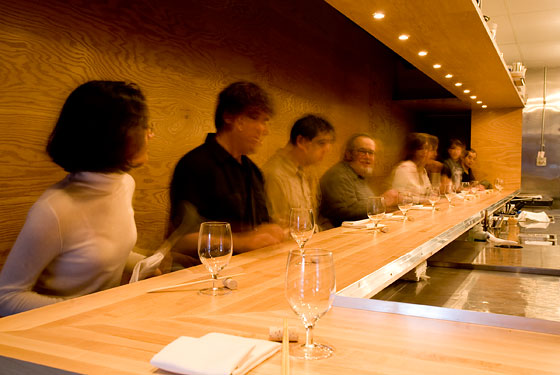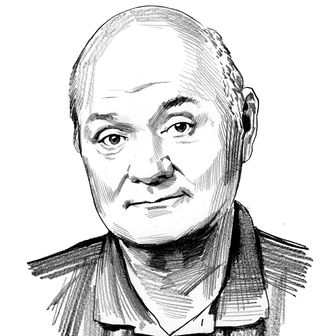
According to the exacting code laid down by the original food mandarins at Michelin (and normally adhered to by this critic), a reviewer isn’t supposed to pass judgment on a restaurant after just one visit. But then the newest addition to David Chang’s white-hot East Village dining empire, Momofuku Ko, isn’t a restaurant in the normal sense of the word. You could call it a semi-exclusive dining club, but that wouldn’t be quite accurate either. The murmuring, deferential patrons who manage to find a spot at the modest, twelve-seat bar are chosen at random, by a computerized system that seems designed not to entice people to dine at Momofuku Ko but to drive them away. These seats can be booked only a week in advance, and only by logging on to the Momofuku Website. The computer begins taking reservations each morning at ten o’clock, and thanks to the legions of devoted and increasingly frantic Chang groupies (the 30-year-old chef was just nominated for his third James Beard award, and has been the subject of many glowing profiles in many glossy magazines), they’re gone not in minutes but in seconds. Under these trying conditions, getting in the door once, let alone the three times most critics prefer, could take months or even years.
So how do you crack this fiendishly egalitarian, New Age reservation system? It helps to have the services of many diligent assistants willing to peck at their keyboards like gaming zombies for an entire week. Is it worth the aggravation? This depends, I suppose, on your point of view. One reason Chang is regarded as a revolutionary by a new generation of diners and cooks is his gleeful willingness to take the old-line, haute cuisine restaurant conceits and smash them to bits, while still cooking inventive, high-quality food. The name of this willfully anonymous anti-restaurant is barely visible on the door, and the façade is sheathed in what looks like high-tech chicken wire. Inside, there are no waiters, no decorations on the plain butcher-block walls, and no printed menu. Chang’s inspiration is the classic Japanese bar-dining model practiced, most notably in New York, by Masa Takayama at his uptown restaurant, Masa. But the price of a single omakase meal at Masa is $400. At Momofuku Ko, my leisurely, inventive, often wickedly delicious ten-course dinner cost $85.
“We charge cook’s prices” is how Chang puts it to one of the patrons at the bar. He is standing with the rest of his cooks, who look the way top-line restaurant cooks usually do, which is to say pallid and harried, with assorted random baseball caps on their heads and their sleeves rolled up to give their burn marks full display. The first impression you get at Momofuku Ko, in fact, is that this is a kind of kitchen slave’s revolt, an operation run by hypergifted line cooks for the benefit of their downtrodden, misunderstood, back-of-the-house brethren. A loop of up-tempo kitchen tunes (Led Zeppelin, the Clash, Iggy Pop) plays over the stereo, and many of the pale, observant, food-obsessed patrons look like they’ve been working over hot stoves themselves.
The first amuse item is Chang’s calling card (and that beloved kitchen favorite), a crackly, feathery curl of pork rind. The second is a candy-size “housemade” English muffin slathered with more salty pork fat. The grateful food geek next to me pops it into his mouth. “I’ll eat that for breakfast any day,” he says. Chang’s somewhat outsize reputation has been based, until now, on his gift for taking these kinds of humble dishes (bowls of ramen at Momofuku Noodle Bar, or the famous pork butt at Momofuku Ssäm Bar) and imbuing them with the finest ingredients, and topflight technique. But Momofuku Ko (ko means “son of” in Japanese) is the chef’s first attempt at ambitious, haute cuisine cooking, and as the big dishes appear, the meal picks up steam. A tangle of gummy fluke is overwhelmed by too much yuzu and hot Sriracha pepper. But after that comes a classic Changian creation, a bowl of technically perfect French consommé cut with a hint of kimchee purée (“Korean consommé,” the chef calls it) and garnished with a square of frizzled, gently melting pork belly and a briny oyster from Cape Cod. A soft-cooked egg is next, only this egg has been smoked and then cut open so that the smoky-sweet yolk runs into a pleasing mix of caviar (from Tennessee), tangy sweet-potato vinegar (from Japan), and a pile of crunchy, nickel-size potato chips.
Chang and his cooks personally serve these dishes, giving dour, somewhat perfunctory descriptions of them, the way waiters at fancy restaurants are supposed to do. After the egg come two buttery, salty, perfectly seared scallops that have been foraged (the cooks wish me to know) off the New Jersey coast. They’re scattered with peanuts, among other things, and their sweetness is enhanced by a smoky vinaigrette infused with more bacon. Next up is the foie gras course, which doesn’t look like any foie gras course I or the increasingly convivial food geeks at the bar have ever seen. It looks like a heaping pile of bread crumbs, only the bread crumbs turn out to be shavings of a pink foie gras torchon, which has been salted and frozen overnight. Underneath are spoonfuls of White Riesling gelée, bits of pine-nut brittle, and segments of litchi, all of which dissolve in a rainbow of textures and flavor, as the cool foie gras dissolves in your mouth.
Am I sounding like a worshipful food geek myself? Maybe it’s the madcap, quixotic nature of Chang’s new enterprise (most chefs in his position cash out in Vegas; they don’t open high-minded twelve-seat restaurants). Or maybe it’s the final savory course, a hunk of short rib braised for several days, the way Chang’s Korean mother does, in soy sauce, sugar, and mirin, then deep-fried, like some dense, trencherman’s version of that great regional specialty the fried Snickers bar. Or maybe it’s the desserts, designed by an anonymous technician Chang refers to obliquely as “our dessert fairy.” One is a deep-fried apple pie (an homage to the McDonald’s classic, but about a thousand times better, served with a scoop of sour-cream ice cream), the other is something called “Cereal Milk Panna Cotta.” This ingenious dish is made with the milk from a bowl of corn flakes (which enriches the panna cotta) and plated with a purée of avocado (which cuts the sweetness). One of the cooks watched me as I took one curious bite, then another. “I know, it’s weird,” he said. “It actually works.”
Momofuku Ko
Address: 163 First Ave., nr 10th St.; momofuku.com
Hours: Wednesday through Monday 6 to 10:20 p.m.
Prices: Ten-course prix fixe, $85.
Ideal Meal: The fixed-price menu is constantly evolving. Our favorites so far: kimchee purée, foie gras, deep-fried short rib, cereal-milk panna cotta.
Note: Reservations are gone by 10:05, but cancellations occur throughout the day. Hang over the computer, and you might get lucky.
Scratchpad: Should we subtract a star for the absurd reservation system? But then we’d have to add it right back because the price is so good. And then there’s the food, which Chang, already a multi-star chef, takes to another level.
